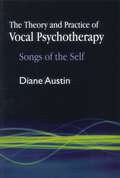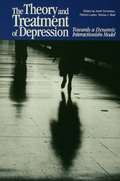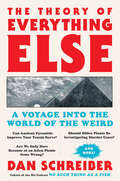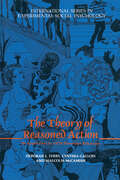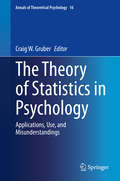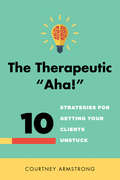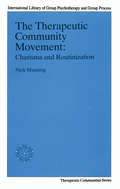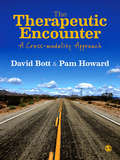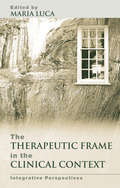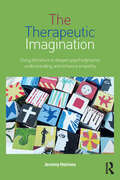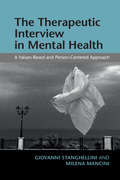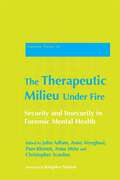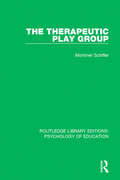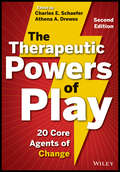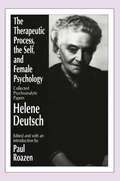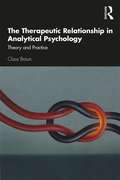- Table View
- List View
The Theory and Practice of Group Psychotherapy, Fifth Edition
by Irvin D. Yalom Molyn LeszczIn this completely revised and updated fifth edition of group psychotherapy’s standard text, Dr. Yalom and his collaborator present the most recent developments in the field, drawing on nearly a decade of new research as well as their broad clinical wisdom and expertise. Among the significant new topics: Online therapy Specialized groups Ethnocultural diversity Trauma Managed care Plus hundreds of new references and clinical vignettes
The Theory and Practice of Positive Neuropsychology: New Perspectives on Nurturing Wellbeing
by K. Jayasankara ReddyThis pioneering work focuses on positive psychology and wellbeing from a neuropsychological perspective. It bridges social, emotional, and psychological principles to explore the burgeoning field of positive neuropsychology.Combining academic theory and clinical practice, it delves into foundational principles, assessments of neuro-cognitive health, evidence-based interventions, practical applications and real-life case studies, and the profound implications of positive neuropsychology in educational contexts. At the intersection between neuropsychology and positive psychology, this book advocates the recent shift toward recognizing the paramount importance of exploring the positive facets of neuropsychological functioning, rather than the historical focus of neuropsychology on ameliorating cognitive deficits and addressing neurological disorders.A must-read for academics, clinicians, and students in neuropsychology, clinical psychology, and positive psychology, this book is also invaluable for anyone interested in enhancing cognitive wellbeing and resilience.
The Theory and Practice of Psychoanalytic Therapy: Listening for the Subtext
by Siri Erika Gullestad Bjørn KillingmoThe Theory and Practice of Psychoanalytic Therapy: Listening for the Subtext outlines the core concepts that frame the reciprocal encounter between psychoanalytic therapist and patient, taking the reader into the psychoanalytic therapy room and giving detailed examples of how the interaction between patient and therapist takes place. The book argues that the therapist must capture both nonverbal affects and unsymbolized experiences, proposing a distinction between structuralized and actualized affects, and covering key topics such as transference, countertransference and enactment. It emphasizes the unconscious meaning in the here-and-now, as well as the need for affirmation to support more classical styles of intervention. The book integrates object relational and structural perspectives, in a theoretical position called relational oriented character analysis. It argues the patient’s ways-of-being constitute relational strategies carrying implicit messages – a "subtext" – and provides detailed examples of how to capture this underlying dialogue. Packed with detailed clinical examples and displaying a unique interplay between clinical observation and theory, this wide-ranging book will appeal to psychotherapists, psychoanalysts and clinical psychologists in practice and in training.
The Theory and Practice of Vocal Psychotherapy: Songs of the Self
by Diane AustinThe voice is the most powerful and widely used instrument in music therapy. This book demonstrates the enormous possibilities for personal change and growth using a new, voice-based model of psychotherapy where the sounds of the voice are expressed, listened to and interpreted in order to access unconscious aspects of the self and retrieve memories, images and feelings from the past. Combining theory with practice, the book explains the foundations of vocal psychotherapy and goes on to explore its usage in clinical practice and the various techniques involved. The book integrates important concepts from depth psychology such as regression, reenactment and working with transference and counter-transference with the practice of vocal music therapy. Drawing on over twenty years of research, the author uses case studies to illustrate specific vocal interventions, including improvisation techniques such as vocal holding, free associative singing and psychodramatic singing. Vocal Psychotherapy highlights the value of voice work as an integral part of the psychotherapeutic process and provides a model of advanced clinical work that will be essential reading for music and creative arts therapists.
The Theory and Treatment of Depression: Towards a Dynamic Interactionism Model
by Patrick Luyten Sidney J. Blatt Jozef CorveleynRecent research indicates that depression, once believed to be relatively benign, is highly recurrent and does not respond well to treatment. The goal of this book is to facilitate the development of more encompassing theories and more effective treatments for this disabling disorder by fostering dialogue and enhancing the integration of work across the boundaries of separate fields.
The Theory of Cultural and Social Selection
by W. G. RuncimanIn The Theory of Cultural and Social Selection, W. G. Runciman presents an original and wide-ranging account of the fundamental process by which human cultures and societies come to be of the different kinds that they are. Drawing on and extending recent advances in neo-Darwinian evolutionary theory, Runciman argues that collective human behaviour should be analyzed as the acting-out of information transmitted at the three separate but interacting levels of heritable variation and competitive selection - the biological, the cultural, and the social. The implications which this carries for a reformulation of the traditional agenda of comparative and historical sociology are explored with the help of selected examples, and located within the context of current debates about sociological theory and practice. The Theory of Cultural and Social Selection is a succinct and highly imaginative contribution to one of the great intellectual debates of our times, from one of the world's leading social theorists.
The Theory of Everything
by Kari LunaOne part Libba Bray's GOING BOVINE, two parts String Theory, and three parts love story equals a whimsical novel that will change the way you think about the world. Sophie Sophia is obsessed with music from the late eighties. She also has an eccentric physicist father who sometimes vanishes for days and sees things other people don't see. But when he disappears for good and Sophie's mom moves them from Brooklyn, New York, to Havencrest, Illinois, for a fresh start, things take a turn for the weird. Sophie starts seeing things, like marching band pandas, just like her dad. Guided by Walt, her shaman panda, and her new (human) friend named Finny, Sophie is determined to find her father and figure out her visions, once and for all. So she travels back to where it began--New York City and NYU's physics department. As she discovers more about her dad's research on M-theory and her father himself, Sophie opens her eyes to the world's infinite possibilities--and her heart to love. Perfect for fans of Going Bovine, The Perks of Being a Wallflower, Scott Pilgrim vs. The World and The Probability of Miracles.
The Theory of Everything Else: A Voyage Into the World of the Weird
by Dan Schreiber"Absorbing. ... As thoughtfully written as it is nuts." —Chicago TribuneA collection of the world’s most mind-boggling, thought-provoking, and downright hilarious theories by the co-host of the hit podcast No Such Thing as a Fish, Dan Schreiber.Why are we here? Do ghosts exist? Will we ever travel back in time? Are we being visited by extraterrestrials? Will we ever talk to animals? Are we being told the truth? Are mysterious creatures roaming the Earth? And why, when you’re in the shower, does the shower curtain always billow in towards you?We don’t know the answers to any of these questions (that includes the shower-curtain one, which is a mystery that has eluded scientists for decades, and which they are still trying to solve). But don’t worry, no matter what questions you have, you can bet on the fact that there is someone (or something) out there, investigating it on your behalf—and Dan Schreiber collects their latest findings.From the Silicon Valley tech billionaires currently trying to work out whether or not the universe is one giant video game simulation to the self-proclaimed community of Italian time-travelers who are trying to save the world from destruction; The Theory of Everything Else will act as a handbook for those who want to think differently.
The Theory of Reasoned Action: Its application to AIDS-Preventive Behaviour (International Series in Social Psychology #No. 28)
by Cynthia Gallois Deborah J. Terry Malcolm McCamishThe Theory of reasoned action explores the theory and emphirical reserach in to the factors which influence whether people engage in high-risk practices , with specific reference to AIDS education.
The Theory of Statistics in Psychology: Applications, Use, and Misunderstandings (Annals of Theoretical Psychology #16)
by Craig W. GruberThis edition of Annals of Theoretical Psychology focuses on the utilization of statistics and the empirical nature of them as applied to psychology in action. Beginning with statements from the American Statistical Association on the applicability of statistics, the volume moves to a discussion of empiricism in psychology, and the reliance on statistics. The book then branches out to discuss applied aspects of statistics in Emergency management, policing, and technology. In these areas, a tie-in to the relevance of the person in the statistical measures is a prominent aspect for discussion. Finally, the book looks at applicability and use of statistics as descriptors of larger, societal samples as opposed to use for describing individual behavior. This edition is designed to continue the exploration of theoretical psychology as it applies to behavior and the individual, as the last edition, Leader Development Deconstructed, did with examining leaders and leadership."Leaders influence others. Their tools include competence, candor and character. In those first two areas I’ve found statisticians possess a strong foundation for leadership (critical thinking, problem solving, strategic perspective, and risk management) but often lack a comfortable, collaborative temperament which inhibits their maximum effect. In this issue of Annals, Dr. Craig Gruber (a Navy Reserve Intelligence Officer to boot!) combines all three elements of influence which proves why he is regarded as a thought leader in this field. His inclusion in this edition of outstanding works from many subject matter experts’ offers an inclusive and comprehensive approach to understanding the power, impact, and decision advantage of statistics and leadership when effectively paired. Enjoy!"- Rear Admiral Paul Becker, USN (retired), President of The Becker T3 Group, and former Director of Intelligence for the Joint Chiefs of Staff
The Therapeutic "Aha!": 10 Strategies for Getting Your Clients Unstuck
by Courtney ArmstrongA concise guide to shaking things up in therapy. Courtney Armstrong's The Therapeutic "Aha!" explores the thrilling and rare moment when a client reaches an elusive realization, allowing them to make meaningful change. In 10 straightforward strategies, this practical book demonstrates how to shake things up in therapy when a client is stuck or stalled to jumpstart progress. Readers will learn how to spark the "emotional brain"--the part of the brain that houses automatic, unconscious patterns--and create new neural pathways that engage and advance the healing process. Divided into three parts--(1) Awakening a Session, (2) Healing Emotional Wounds, and (3) Activating Experiential Change--the book walks readers through specific techniques for harnessing the emotional brain and re-patterning its routine. Elegant therapeutic insights and coping strategies only go so far; until we intervene with something our emotional brain can understand--a compelling felt experience--old, established neural patterns will persist. The brain-based strategies Armstrong presents include how to enliven the therapeutic alliance; elicit exciting goals; identify the root of an emotional conflict; reverse trauma with memory reconsolidation; invoke inspirational imagery; and use stories, humor, music, poetry, and even mindfulness to induce change. Concise, reader-friendly, and filled with helpful case stories and client-therapist dialogue, this wonderfully accessible book puts a new spin on neuroscience knowledge, showing clinicians exactly how it can be used to make those once-elusive therapeutic breakthroughs more frequent, leading to greater healing for your patients.
The Therapeutic Community Movement: Charisma and Routinisation (Therapeutic Communities Section, International Library Of Group Psychotherapy And Group Processes)
by Nick ManningFirst published in 1989. Routledge is an imprint of Taylor & Francis, an informa company.
The Therapeutic Encounter: A Cross-modality Approach
by Pam Howard David BottThe therapeutic encounter is at the core of counselling and psychotherapy training and practice, regardless of therapeutic modality. This book introduces a cross-modality approach to the client-therapist encounter, drawing from humanistic, psychoanalytic, systemic, and integrative approaches. Chapters introduce a range of client themes - the refusal to join in, the battle for control, the emotionally unavailable etc - and shows how these are enacted in the relationship. The authors invite you, as therapist, to interact creatively with the client, engaging directly in the drama. In this way, they provide a coherent framework within which to understand both the therapeutic relationship and the principles of their approach. This book is highly recommended for any counselling and psychotherapy trainee, regardless of modality. It is a must-read, with each chapter directly addressing essential teaching and trainee concerns. David Bott is the Director of Studies of Counselling and Psychotherapy at the University of Brighton and a UKCP registered Systemic Psychotherapist. Pam Howard is Course Leader of the MA Psychotherapeutic Counselling at the University of Brighton and a UKCP registered Psychoanalytic Psychotherapist
The Therapeutic Frame in the Clinical Context: Integrative Perspectives
by Maria LucaHow does the therapeutic frame help therapists in their practice? The Therapeutic Frame in the Clinical Context examines some of the key issues inherent in the intimate and very often intense therapeutic relationship. It addresses and clarifies perspectives on the creation of a therapeutic environment that is conducive to therapy. The book addresses specific aspects of the therapeutic frame. How does a client feel about unexpectedly meeting her psychotherapist's son or daughter? How does a psychotherapist or counsellor practice within a 'frameless', often intrusive environment, in acute hospital wards? How does a counsellor manage the frame in the face of a life-threatening illness? Using a wealth of examples from clinical practice, The Therapeutic Frame in the Clinical Context examines these issues and more, in a range of settings including the NHS, private practice, and the workplace, and provides valuable guidelines from a range of theoretical perspectives, including Jungian and psychoanalytic.
The Therapeutic Imagination: Using literature to deepen psychodynamic understanding and enhance empathy
by Jeremy HolmesUse of the imagination is a key aspect of successful psychotherapeutic treatments. Psychotherapy helps clients get in touch with, awaken, and learn to trust their creative inner life, while therapists use their imaginations to mentalise the suffering other and to trace the unconscious stirrings evoked by the intimacy of the consulting room. Working from this premise, in The Therapeutic Imagination Jeremy Holmes argues unashamedly that literate therapists make better therapists. Drawing on psychoanalytic and literary traditions both classical and contemporary, Part I shows how poetry and novels help foster therapists’ understanding of their own imagination-in-action, anatomised into five phases: attachment, reverie, logos, action and reflection. Part II uses the contrast between secure and insecure narrative styles in attachment theory and relates these to literary storytelling and the transformational aspects of therapy. Part III uses literary accounts to illuminate the psychiatric conditions of narcissism, anxiety, splitting and bereavement. Based on Forster’s motto, ‘Only Connect’, Part IV argues, with the help of poetic examples, that a psychiatry shorn of psychodynamic creativity is impoverished and fails to serve its patients. Clearly and elegantly written, and drawing on the author’s deep knowledge of psychoanalysis and attachment theory and a lifetime of clinical experience, Holmes convincingly links the literary and psychoanalytic canon. The Therapeutic Imagination is a compelling and insightful work that will strike chords for therapists, counsellors, psychoanalysts, psychiatrists and psychologists.
The Therapeutic Interview in Mental Health: A Values-Based and Person-Centered Approach
by Giovanni Stanghellini Milena ManciniEmotions and values are considered the keys to understanding peoples' experiences and actions within the world they inhabit. The traditional symptom-led clinical interview is frequently criticised for ignoring the narrative of a patient's experience in favour of ticking-off symptoms that can be reduced or controlled. In response, this important new book seeks to understand a patient's sufferings through their individual experiences and values. The Therapeutic Interview in Mental Health is about the art of asking questions. This comprehensive book will equip psychologists, psychiatrists and clinicians with the tools to begin unlocking the emotions and experiences of their patients. The method of the therapeutic interview is explained in a step-by-step way, allowing the reader to understand the clinical interview as a means of beginning a shared understanding between patient and clinician. This book is an essential read for all psychologists, psychiatrists, general clinicians, and medical trainees.
The Therapeutic Milieu Under Fire: Security and Insecurity in Forensic Mental Health
by Jonathan Coe Gwen Adshead Rebecca Neeld Estela Welldon Kingsley Norton Tom Clarke Scanlon Christopher Aiyegbusi Anne Celia Taylor Christopher Scanlon John Adlam Andrew Cooper Martin Wrench Anna Motz Motz Anna Valerie Sinason Alan Corbett Anne Aiyegbusi Earl Hopper Pam KleinotThis groundbreaking book explores the psychodynamics and socio-politics of the forensic therapeutic milieu, addressing some of the most difficult and complex issues facing practitioners. It sets out a psycho-social framework for understanding the predicament and the needs of those who live in and those who work in forensic mental health settings. It brings to life the thinking of those working on the frontline in an increasingly difficult and hostile environment, and draws together fresh and stimulating approaches to engagement with highly complex individuals who present challenges to traditional models of psychiatric assessment and treatment. Contributors with considerable clinical experience and expertise from a range of disciplines consider the ethical, emotional and intellectual challenges of their work, and describe ways in which genuine containment and change can be achieved despite numerous perceived assaults on therapeutic relationships, and on the therapeutic milieu itself. Combining clinical case studies with organisational perspectives and clear descriptions of theoretical processes, they explore key issues including the challenges of maintaining role-appropriate, 'boundaried' relationships; the tensions between public protection and individual confidentiality; questions of risk and responsibility; duty of care and respect for individual liberty; the challenges posed by inter-professional tensions and rivalries; as well as specific clinical dilemmas. The difficulties they experience in fulfilling specific therapeutic roles in the face of uncertainties about the funding and commissioning of their services are addressed, and the final part of the book outlines some of the ways in which individuals, particular services and whole organisations may protect themselves when under attack. This unique and highly original book is essential reading for all those working, or training to work, in both forensic and non-forensic inpatient therapeutic milieux and for academics and lay readers interested in the societal dynamics of inclusion and exclusion that are replicated and magnified in these settings.
The Therapeutic Play Group (Routledge Library Editions: Psychology of Education)
by Mortimer SchifferOriginally published in 1971, this title is a comprehensive and detailed presentation of the principles and practices of an activity-type, experimental form of group therapy which had proved successful with emotionally disturbed, pre-pubertal children at the time. Mortimer Schiffer describes the clinical procedures and rehabilitative programs that were developed, over a period of many years, through experience of more than a hundred therapeutic play groups. One play group, conducted in a public elementary school in an underprivileged community of a large city, is examined from its inception to its termination after more than three years of meetings. Thus the reader is able to study the psycho-dynamics of a group, and to appreciate the special meaning of the school environment when it is used as a setting for therapeutic group practice. As the author says, "The school is not only advantageously situated with respect to the identification of developmental problems in young children, but it also has great potential for carrying out preventive and rehabilitative programs. No other community resource – including the mental health agencies – can match the potential of school-based programs for countering mal-experience in the lives of children." This book will be of interest to psychiatrists, social workers and psychologists who work with emotionally disturbed children, and also to teachers in special education and to other school personnel involved with children who have adjustment problems.
The Therapeutic Powers of Play
by Charles E. Schaefer Athena A. Drewes"Focusing on the specific ingredients that activate clinical change, this book is enhanced by current research, more ample scope, and an array of contributions in contemporary and relevant topic areas. It is full of inspiration, direction, and grounding. This is a stunning contribution to the field of child therapy."-Eliana Gil, PhD, Gil Institute for Trauma Recovery and EducationA practical look at how play therapy can promote mental health wellness in children and adolescentsRevised and expanded, The Therapeutic Powers of Play, Second Edition explores the powerful effects that play therapy has on different areas within a child or adolescent's life: communication, emotion regulation, relationship enhancement, and personal strengths. Editors Charles Schaefer and Athena Drewes-renowned experts in the field of play therapy-discuss the different interventions and components of treatment that can move clients to change.Leading play therapists contributed to this volume, supplying a wide repertoire of practical techniques and applications in each chapter for use in clinical practice, including:Direct teachingIndirect teachingSelf-expressionRelationship enhancementAttachment formationCatharsisStress inoculationCreative problem solvingSelf-esteemFilled with clinical case vignettes from various theoretical viewpoints, the second edition is an invaluable resource for play and child therapists of all levels of experience and theoretical orientations.
The Therapeutic Process, the Self, and Female Psychology: Collected Psychoanalytic Papers
by Helene DeutschHelene Deutsch was one of the most famous psychoanalysts to emerge from Freud's immediate circle in Vienna. Best known for her writings on female psychology, she was also one of the great teachers of psychoanalysis. As the founding president of the Vienna Psychoanalytic Training Institute, she confirmed her stature in the history of psychoanalysis by cultivating a whole younger generation of influential analysts. Deutsch was tolerant and open-minded, both as a theoretician and teacher, but, as Paul Roazen remarks in his introduction, independence and an absence of fanaticism can mean a temporary fading out of influence. For the first time, Deutsch's major professional contributions are brought together for permanent consideration. This volume documents her enduringly valuable exploration of the complexities of the psychology of women's experience.Deutsch remained essentially faithful to the Freudian canon. Nonetheless, and throughout these writings, she developed ideas on the subject of femininity that were often at odds with those of her mentor. Her use of Freud's theories aimed to encourage toleration of human diversity and to modify his model of sexuality according to the particular circumstances of women's lives. It was Deutsch who introduced motherhood as a central concern of psychoanalysis by stressing how the psychological dimension of reproduction was different for men and women and how this uniquely feminine capacity had its effects on the entire psychology of women.The same commitment to human diversity informs her much-misunderstood work on the clinical problems of female sexual dysfunction. While accepting the Freudian goal of sexual gratification, Deutsch argues that sublimation through work was a key value in its own right This is illustrated in "George Sand: A Woman's Destiny," a brilliant early example of psychobiography. This volume of Deutsch's classic papers, several appearing in English for the first time, will be of interest to psychologists, intellectual historians, and women's studies specialists.
The Therapeutic Relationship in Analytical Psychology: Theory and Practice
by Claus BraunIn The Therapeutic Relationship in Analytical Psychology: Theory and Practice Claus Braun presents a thorough exploration of the importance of the therapeutic relationship and explains how to encourage and develop it. Drawing on Braun’s decades of clinical experience, the book clearly demonstrates the significance of establishing an intensive and living connection between client and analyst. The book examines the crucial steps of the psychotherapeutic process, illustrated with a detailed case study that presents the personal development of an analysand through a series of dreams and drawings. Braun connects key concepts in analytical psychology, such as complexes, symbols, archetypes and amplification, with conscious and unconscious processes and the development of the therapeutic relationship during the analytic process. The book also examines why C. G. Jung put such a special emphasis on the therapeutic relationship and explores the ethical demands and social responsibilities of the analyst. Comprehensive and insightful, it skillfully makes the connection between Jung’s analytical psychology and practical psychotherapeutic work. The Therapeutic Relationship in Analytical Psychology will be an essential text for Jungian analysts and psychotherapists in practice and in training and a key reference for academics and students of analytical psychology, psychotherapy and Jungian studies.
The Therapeutic Relationship in Cognitive Behavioural Therapy
by Stirling Moorey Anna LavenderThe therapeutic relationship in CBT is often reduced to a cursory description of establishing warmth, genuineness and empathy in order to foster a collaborative relationship. This does not reflect the different approaches needed to establish a therapeutic partnership for the wide range of disorders and settings in which CBT is applied. This book takes a client group and disorder approach with chapters split into four sections: General issues in the therapeutic relationship in CBT Therapeutic relationship issues in specific disorders Working with specific client groups Interpersonal considerations in particular delivery situations Each chapter outlines key challenges therapists face in a specific context, how to predict and prevent ruptures in the therapeutic alliance and how to work with these ruptures when they occur. With clinical vignettes, dialogue examples and ‘tips for therapists' this book is key reading for CBT therapists at all levels.
The Therapeutic Relationship in Cognitive Behavioural Therapy
by Stirling Moorey Anna LavenderThe therapeutic relationship in CBT is often reduced to a cursory description of establishing warmth, genuineness and empathy in order to foster a collaborative relationship. This does not reflect the different approaches needed to establish a therapeutic partnership for the wide range of disorders and settings in which CBT is applied. This book takes a client group and disorder approach with chapters split into four sections: General issues in the therapeutic relationship in CBT Therapeutic relationship issues in specific disorders Working with specific client groups Interpersonal considerations in particular delivery situations Each chapter outlines key challenges therapists face in a specific context, how to predict and prevent ruptures in the therapeutic alliance and how to work with these ruptures when they occur. With clinical vignettes, dialogue examples and ‘tips for therapists′ this book is key reading for CBT therapists at all levels.
The Therapeutic Relationship in Cognitive-Behavioral Therapy: A Clinician's Guide
by Judith S. Beck Nikolaos Kazantzis Frank M. Dattilio Keith S. DobsonFrom leading cognitive-behavioral therapy (CBT) experts, this book describes ways to tailor empirically supported relationship factors that can strengthen collaboration, empiricism, and Socratic dialogue and improve outcomes. In an accessible style, it provides practical clinical recommendations accompanied by rich case examples and self-reflection exercises. The book shows how to use a strong case conceptualization to decide when to target relationship issues, what specific strategies to use (for example, expressing empathy or requesting client feedback), and how to navigate the therapist's own emotional responses in session. Special topics include enhancing the therapeutic relationship with couples, families, groups, and children and adolescents. Reproducible worksheets can be downloaded and printed in a convenient 8 1/2" x 11" size.
The Therapeutic Relationship in Counselling and Psychotherapy (Essential Issues in Counselling and Psychotherapy - Andrew Reeves)
by Mick Cooper Rosanne KnoxWhat is a therapeutic alliance? How do I create a bond? What might lead to the alliance breaking down? What do I do when the relationship feels stuck? These are just some of the questions addressed in this important new book for trainee and qualified therapists wanting to understand, engage in and make the most of the therapeutic relationship. Taking you through each stage of the therapeutic process, from initial boundary setting to effective endings, the book considers a number of different settings and client groups such as working in an online environment and with children and young people. Structured around ‘Frequently Asked Questions’, an accessible and engaging narrative guides you though the skills and considerations for an effective therapeutic relationship, as well as the potential challenges it might face. Bringing to the forefront the mutuality of the relationship and the client as a proactive agent, this book will equip you with the knowledge and skills needed to develop trusting and productive relationships with your clients.



